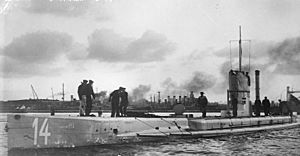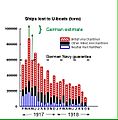First Battle of the Atlantic facts for kids
Quick facts for kids Battle of the Atlantic |
|||||||
|---|---|---|---|---|---|---|---|
| Part of World War I | |||||||
|
|||||||
| Belligerents | |||||||
Royal Canadian Navy, United States Navy Navy of France |
Navy of the German Empire |
||||||
| Commanders and leaders | |||||||
| Reinhard Scheer | |||||||
The First Battle of the Atlantic (1914–1918) was a major naval fight during World War I. It mostly happened in the seas around the British Isles and the Atlantic Ocean.
Both the German Empire (Germany) and the United Kingdom (Britain) needed to import lots of food and supplies. These imports were vital for their people and their war factories. So, both sides tried to stop the other's ships from reaching their ports. This is called a blockade.
Britain had the powerful Royal Navy, which had more ships. It could also operate easily across the British Empire. The German Navy could not defeat the British Navy in a big battle, as seen at the Battle of Jutland.
Instead, the German fleet mainly used submarines. They used a tactic called "unrestricted submarine warfare." This meant they would sink any ship, even passenger or merchant ships, without warning.
Neutral countries, like the United States, did not like these blockades. The sinking of the passenger ship RMS Lusitania especially angered the United States.
Britain's successful blockade of Germany helped lead to Germany's military defeat in 1918. The blockade stayed in place even after the fighting stopped. It helped make Germany sign the Treaty of Versailles in mid-1919. This treaty officially ended the war.
Contents
Understanding the War at Sea
Submarines, also known as U-boats (from the German Unterseeboot), were a new and scary weapon. They could sneak underwater and attack ships without being seen. This made them very dangerous for merchant ships carrying supplies.
Germany used its U-boats to try and cut off Britain's supplies. This was a big challenge for Britain, as it relied on ships for food and other goods.
The Impact of German U-Boat Attacks
German U-boats sank many ships during World War I. In 1917, they sank a huge amount of shipping. For example, in April 1917 alone, over 881,000 tons of Allied and neutral ships were sunk. This was the highest loss of the entire war.
To fight back, the British started using a "convoy system" in September 1917. This meant merchant ships traveled in large groups, protected by warships. This made it much harder for U-boats to attack them.
German Submarine Strength and Losses
Germany started the war with a small number of submarines. But they built many more throughout the war. By 1917, they had over 130 operational U-boats.
However, many German submarines were also sunk. About half of all the U-boats built during the war were lost in combat. This shows how dangerous submarine warfare was for both sides.
Images for kids
-
German U-boats at Kiel, February 1914
-
German depiction of the sinking of HMS Formidable by SM U-24
-
Diagram of the North Sea Mine Barrage, a large mine field to inhibit U-boat access to the Atlantic Ocean from the approaches between Orkney Islands to Norway











